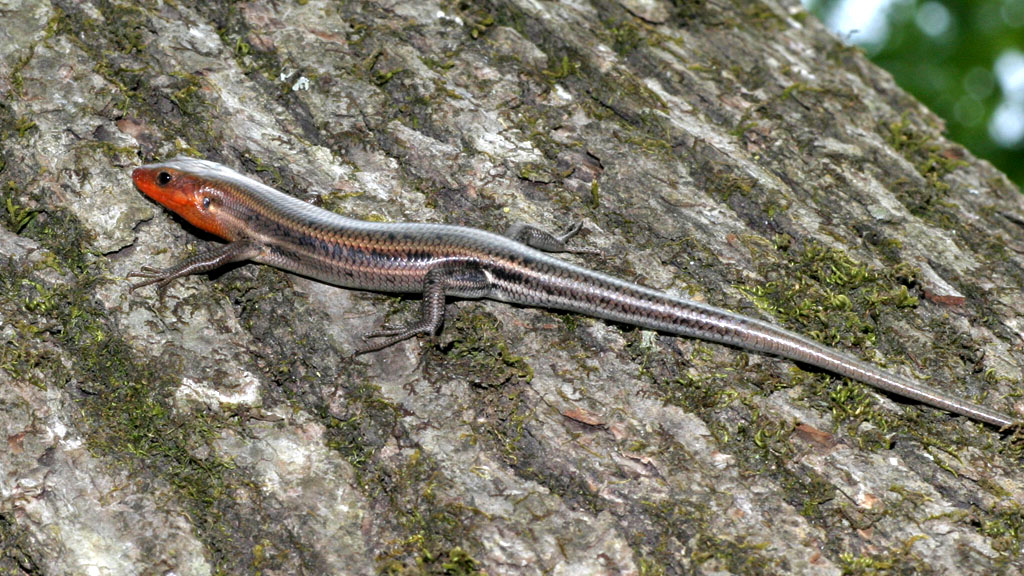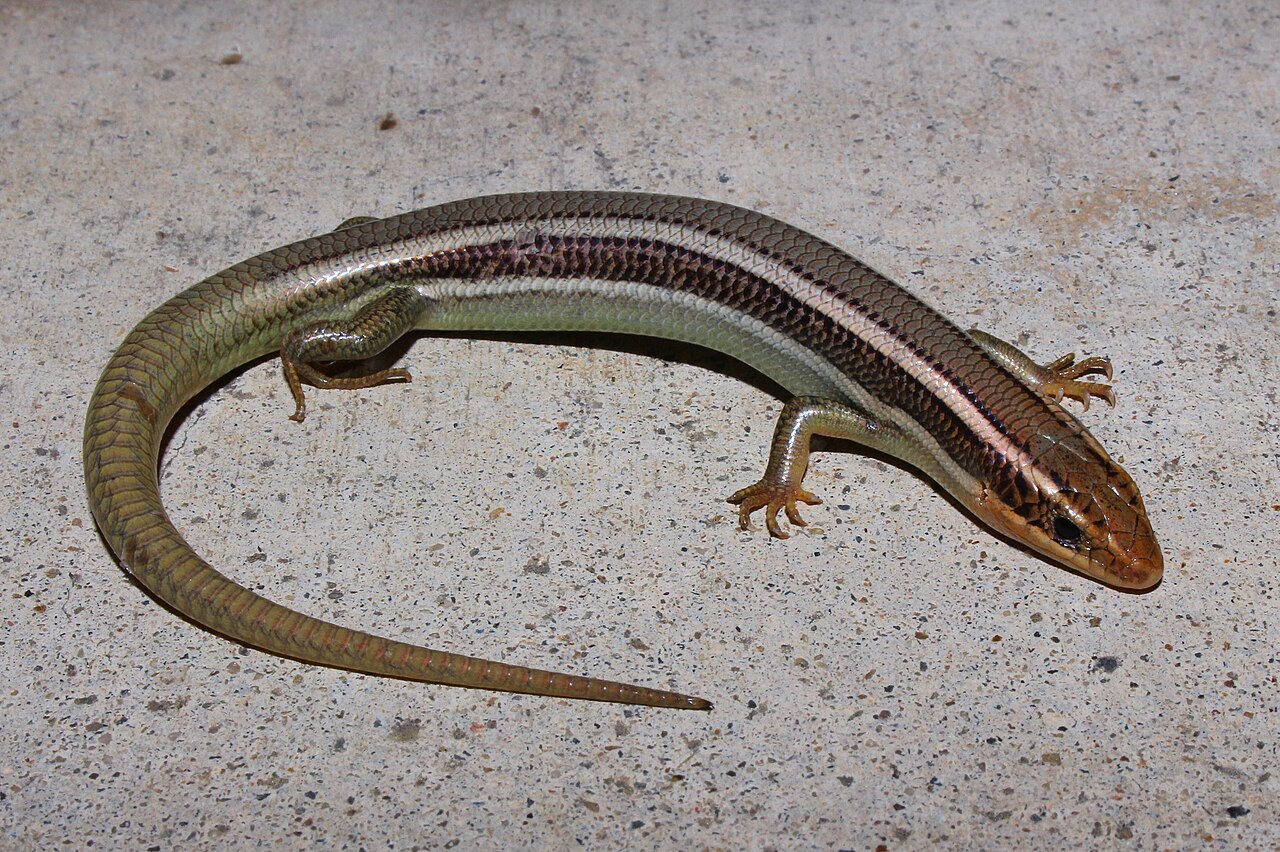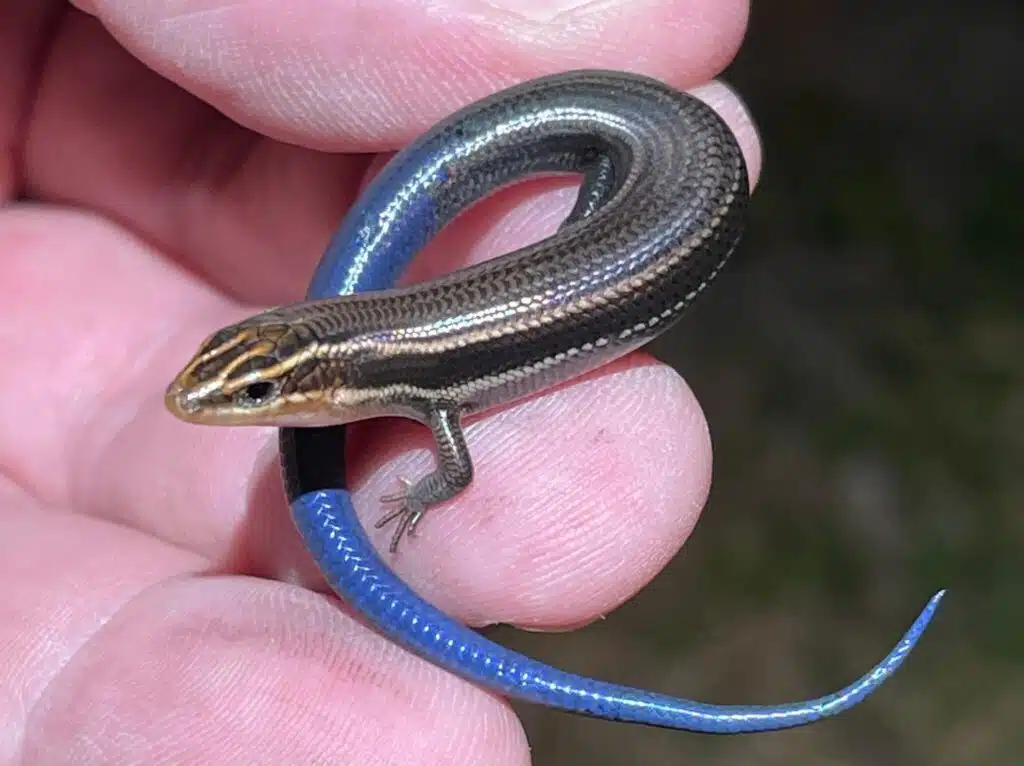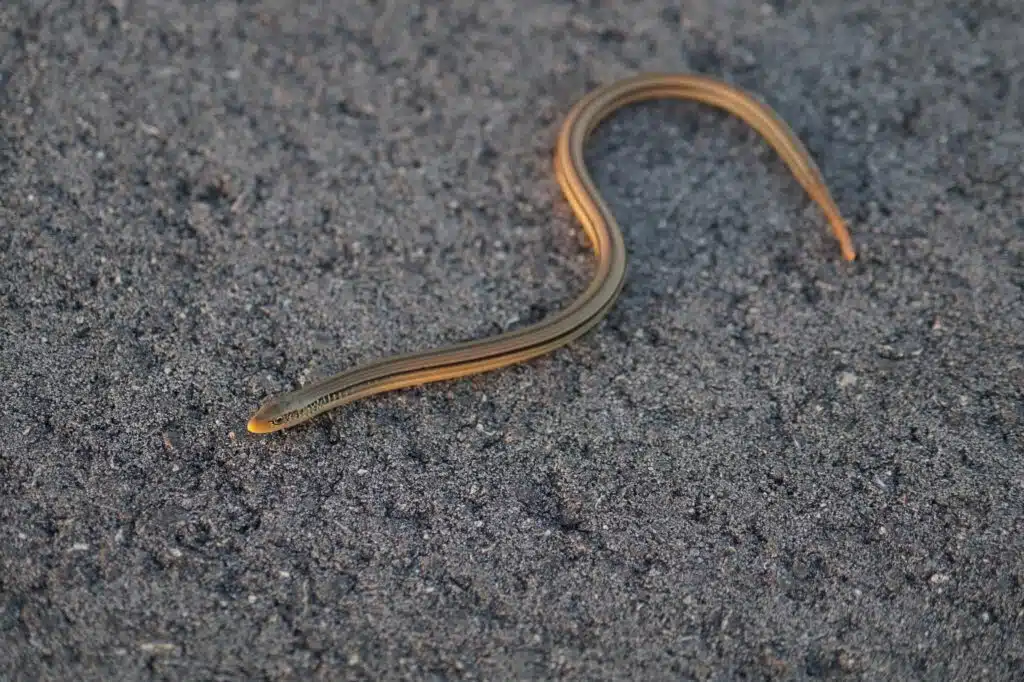Striped lizards are found in various regions of the United States. Southern territories tend to attract most species of lizards with stripes.
From skinks to whiptails, lizards may exhibit stripes as adults or as juveniles. Highly variable in coloring and patterns, they may even change their color patterns throughout their lifetime.
Table of Contents
Are Striped Lizards Poisonous or Venomous
Striped skinks look dangerous and sometimes similar to snakes. They may exhibit a multicolored body and vivid colors which would signal a potentially-dangerous specimen.
Striped lizards aren’t venomous or dangerous to humans. They aren’t venomous and they rarely bite.
In fact, striped lizards make great pets. They might not like to be handled as they run away from humans, but they can live up to 10 years (depending on the species) even in captivity.
The following species are some of the most common types of lizards with stripes in North America.
Types of Striped Lizards
1. Common Five-lined Skink

Common Five-lined Skinks (Plestiodon fasciatus) are a highly common species in the Eastern US states, from Florida and Texas to Michigan.
The skink is named after its stripes. There are 5 total stripes, with 2 stripes on each side, arranged after a central mid-dorsal stripe.
These stripes have a bright color. White or pale yellow, the stripes are only colorful on the head of the skink as they are read in this section.
A gray or black species, this skink also has a contrasting tail. Its tail is blue or blue-purple and can break off in case of an attack.
Stripe color – white, yellow, red
2. Western Whiptail

A spotted and striped appearance is specific to The Western Whiptail (Aspidoscelis tigris). While it may also appear without stripes, most Western Whiptails show stripes from a young age.
4 bright stripes are seen on its back. These are yellow, cream, or white stripes.
In some morphs, the stripes can have a tan color. The spots between the stripes are mostly black, gray, or yellow.
Reaching a size of up to 12 inches, Western Whiptails is a species native to the Southern and Southwestern US regions as well as to parts of Northern Mexico.
The best time to spot the species includes the period between April and August.
Stripe color – yellow, cream, tan
3. Little Brown Skink

Little Brown Skinks (Scincella lateralis) have lateral stripes and a wide central mid-dorsal stripe. The copper color of its mid-dorsal stripe is contrasted by lateral black stripes which are always narrower.
One of the smallest reptiles in the Eastern and Southeastern parts of The United States, Little Brown Skinks maybe as small as 3 inches.
These types of reptiles have different sizes between the sexes. Females are larger but males have a larger head which is believed to attract more breeding partners.
Woodlands represent its ideal habitat. From Ohio to Louisiana, this species may be found in all types of dry woodlands.
Stripe color – copper, black
4. Six-lined Racerunner

A species with a very long tail, Six-lined Racerunenrs (Aspidoscelis sexlineatus) are another common species in woodlands and grasslands.
This type of reptile has a dark and contrasting appearance only bright on its stripes. 6 yellow and white stripes are seen along its dorsum.
A darker nuance is specific to the mid-dorsal stripes while those on the sides are brighter and even white.
The species itself is dark brown or even black, but its bright stripes are seen both on the body and on the tail.
Feeding on insects, The Six-lined Racerunner is a diurnal species that may be spotted running around vegetation during the day.
Stripe color – white, yellow, brown
5. Western Skink

Western Skinks (Plestiodon skiltonianus) are among the most common types of stripes skinks in Western North America.
Reptiles of the species are seen in a widespread habitat from Western Canada to Northwestern Mexico.
This is a species with a striped appearance, brown, and black coloring.
It shows central brown stripes on its dorsum with thin black and white stripes on its back.
Juveniles look similar to adults but stand out with their blue tails. Eventually, their tails take on the color of the rest of the body as the reptile matures.
Stripe color – black, white, brown
6. Southeastern Five-lined Skink

There are 3 stripes on each side of The Southeastern Five-lined Skink (Plestiodon inexpectatus). This species is characterized by a darkening nature as it ages.
Its darkening stripes are initially dark white, but yellow over time. A black wide central stripe is marked by bright stripes above and below, on each side of the body.
Red-brown nuances are specific to this species which slowly comes brown as it matures.
Growing to a size of up to 12 inches, this specie lives in a habitat spreading from Texas to Florida.
They live in different types of woodlands in the Southeastern states.
Stripe color – black, white, yellow
7. Brown Basilisk

Brown Basilisk (Basiliscus vittatus) is a type of basilisk lizard. Also referred to as The Striped Basilisk, this is a species with a bright green dorsal stripe.
An additional white stripe is seen along its neck.
Some morphs of the species show all-green stripes, including those on the neck which expand up to the front legs.
Growing up to a size of 24 inches, this type of basilisk lives in Central US states. It’s also known as a pet lizard as it can survive almost a full decade in captivity.
Brown Basilisks are also known to rapidly walk on water for short distances, a trait that has been speculated by numerous myths associated with the species.
Stripe color – bright green
8. Slender Glass Lizard

Looking similar to a snake, Slender Glass Lizards (Ophisaurus attenuatus) have a striped appearance. These types of lizards have brown, light, brown, and black stripes which run from head to tail.
A total of 6 stripes of various widths are specific to this species.
The wider stripes are characteristic of its upper dorsal areas while the narrower stripes are seen along its sides.
A Central and Southeastern US species, Slender Glass Lizards feed on various insects and bugs such as crickets.
They are also prey for large predators given their large size and slow movements.
Stripe color – brown, black
9. Orange-throated Whiptail

A black species with contrasting bright stripes, The Orange-throated Whiptail (Aspidoscelis hyperythrus) has a striped body and tail.
There are 6 narrow stripes that run from head to tail on its dorsum.
Part of a group of lizards known as whiptails, this species isn’t named after its striped back but after its orange neck.
There’s a bright orange or orange-red patch under its neck while its belly is white.
Juveniles of the species also exhibit blue tails.
A common sight in California, Orange-throated Whiptails may be spotted during the day just outside metropolitan San Diego.
It’s here that the whiptail feeds on spiders, termites, and other insects.
Stripe color – white, cream, yellow
10. Common Spotted Whiptail

Growing to a size between 6 and 11 inches, Common Spotted Whiptails (Aspidoscelis gularis) are named after their spots.
These whiptails have brown and black stripes and white, yellow, and blue spots between the stripes and over the lateral stripes.
The species may be dark on the dorsum, but it features a pink-red neck color and bright blue sections on the belly.
The tail is similar to the back, with a pattern of stripes and small dots.
Some of the rare morphs of the species feature green stripes on the head and on the upper back.
This whiptail also stands out by having a tail longer than its body, believed to be a defensive adaptation.
Stripe color – gray, white, green
11. Sonoran Spotted Whiptail

A species of the Southern US states and The Sonoran Desert, The Sonoran Spotted Whiptail (Aspidoscelis sonorae) has a striped dorsum.
This species shows vivid red stripes and dots in between. These stripes run from head to tail but they appear duller on the tail.
A mostly dark gray, brown, and black species, this whiptail has a brighter tail in all of its morphs.
While yellow dots are common along the yellow dorsal stripes, there’s a Sonoran Spotted Whiptail morph without any spots.
Whiptails of this species are adapted to their rocky and sandy habitats for camouflage.
Stripe color – yellow, pale yellow
12. Plateau Striped Whiptail

A whiptail of the South and Southwestern US territories, Plateau Striped Whiptails (Aspidoscelis velox) have a striped dorsum.
The base color of their backs is black and contrasted by yellow or orange stripes. The stripes continue on its tail in a faint manner.
A species that has a longer tail than its body, this type of whiptail gets its dorsal stripes from an early age.
Its tail is the one section that changes colors in time. Juveniles have all-blue tails where stripes aren’t visible yet.
Stripe color – yellow
13. Desert Grassland Whiptail

Growing to a size between 2 and 5 inches, Desert Grassland Whiptails (Aspidoscelis uniparens) are a typical North American species with stripes.
Their typical appearance makes them highly similar to The Plateau Striped Whiptail, it features a black dorsum and white or cream stripes.
Its dorsum is black or dark brown while its sides are gray, as is its tail which only shows faint stripes.
A white underbelly completes the appearance of the species.
Stripe color – white, cream, yellow
14. Four-lined Skink

A species of Central and Southern Texas, the Four-lined Skink (Plestiodon tetragrammus) is a striped skink with 2 recognized subspecies.
Similar at first, these subspecies differ by the length of their stripes and by their main color.
One is gray while the other one is black. The stripes run to the tailor to the legs on the subspecies.
Yellow stripes are seen on their black or gray bodies with adults having a uniform color as opposed to juveniles.
The young Four-lined Skinks have a vivid blue tail which becomes either gray or black in adulthood.
Stripe color – yellow
15. Little Striped Whiptail

A striped appearance is specific to The Little Stripped Whiptail (Aspidoscelis inornatus).
White stripes or pale yellow stripes are seen along its black dorsum. This is a species with a clear tail without any stripes.
The number of stripes on its dorsum is believed to be variable. Up to 8 white stripes are seen on its mid and side dorsum.
Spotted around the Chihuahuan Desert, The Little Striped Whiptail is a species that is also known as the Severn Striped Whiptail despite often having 8 or even 6 stripes on its back.
The species is diurnal and spotted next to desert vegetation.
Stripe color – yellow, white
16. Prairie Skink

Found in central US states, Prairies Skinks (Plestiodon septentrionalis) have white and yellow stripes. Some of their yellow stripes may be darker, closer to bright brown.
This species is found in some of the Northern states in the US as well. It manages to survive the cold weather here by burrowing.
Prairies Skinks are good burrowers as they dig deep to avoid the cool temperatures in this part of the country.
They use these burrows to enter hibernation. There’s a long hibernation period for the species which lasts between 6 and 8 months.
Stripe color – yellow, white
17. New Mexico Whiptail

Growing to a size of at least 6 inches, New Mexico Whiptails (Aspidoscelis neomexicanus) are a striped whiptail species with several morphs.
A common black morph comes with bright yellow stripes and spots between the stripes.
More visible differences exist on the underside of the whiptail as it can be white or blue.
Juveniles also show a different tail color which may be brighter, typically of a blue shade.
This species reproduces through parthenogenesis. This is a type of asexual reproduction and its high numbers make it a common presence in the South.
New Mexico Whiptails are the chosen representative reptile of The New Mexico State.
Stripe color – yellow, white
18. Many-lined Skink

White and black stripes are seen on the gray-olive Many-lined Skink (Plestiodon multivirgatus). This is one of the skinks where with variable stripe length.
Black stripes are seen along its dorsum and tail while white stripes are seen only along its body and not on its tail.
The olive nuance of its body is specific both to its body and to its tail.
Found at low altitudes and medium elevations, Many-lined Skinks grow to a size of up to 7 inches.
Stripe color – black, white
19. Rainbow Whiptail

A multicolored species of South America, Rainbow Whiptails (Cnemidophorus lemniscatus) have a colorful appearance as their name suggests.
Nuances of green and blue are dominant in the species.
Its main color may be emerald green or blue. Rainbow Whiptails are also among the few reptiles that have a dark blue ventral color.
The stripes on its back are mostly green, green-blue, dark green, or brown. They are combined with spots along the sides.
Brown, tan, or blue sides are seen on the whiptail.
Colombia, Brazil, and Costa Rica’s moist forests area are their preferred habitats.
Stripe color – green, yellow, brown, white
20. Island Glass Lizard

A species of Florida and Georgia, Island Grass Lizards (Ophisaurus compressus) have a bright brown or dark brown stripes appearance.
The stripes seen on its dorsum have multiple colors. They can be brown, tan, or mostly black. One central dorsal stripe is seen on the species while its lateral stripes are mostly black.
Its stripes don’t run from head to tail as the head section of the species is dominated by black spots.
Stripe color – brown, black
21. Southwestern Fence Lizard

A gray or dark golden species, The Southwestern Fence Lizard (Sceloporus cowlesi) is among the species with stripes and a variable appearance.
While a blotched Southwestern Fence Lizard morph exists, this is a species that is mostly known for gray mid-dorsal stripes and yellow lateral stripes.
Found in the Southeastern parts of The United States, the specie may locally be known as The Sand Lizard.
The species may go into hibernation in the cool months of the year.
Stripe color – yellow, gray, white
22. Chihuahuan Spotted Whiptail

The Southwestern Fence Lizard shares the same habitat as The Chihuahuan Spotted Whiptail (Aspidoscelis exsanguis), both species of The Chihuahuan Desert.
Gray and brown stripes dominate the dorsum of the species.
Reaching a maximum length of 12 inches, The Chihuahuan Spotted Whiptail also displays bright yellow spots or white spots on the black sections of its dorsum.
Its underbelly is either pale or bright blue.
Stripe color – gray, gray-brown
23. Gilbert’s Skink

Gillbert’s Skinks (Plestiodon gilberti) are a small species of skink that only grows to a maximum size of 4.5 inches. A native in the Southwestern United States, this species is mostly associated with The San Joaquin Valley.
Juvenile Gilbert’s Skinks have multiple lateral stripes on its body. This is a species that loses its stripes and becomes a uniformly-colored adult skink.
Once an adult, this skink may be brown, gray, or even olive.
Most of Gilbert’s Skink populations are found in California and Baja California. One of its 5 subspecies is found further away in Arizona.
Stripe color – brown, black